Govert Bidloo
Govert Bidloo or Govard Bidloo (12 March 1649 – 30 March 1713) was a Dutch Golden Age physician, anatomist, poet and playwright. He was the personal physician of William III of Orange-Nassau, Dutch stadholder and King of England, Scotland and Ireland.
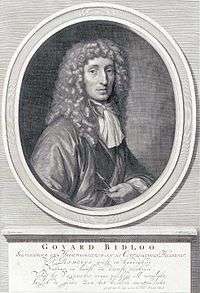
Bidloo was also a prolific and popular poet, opera librettist, and playwright. He wrote the libretto for the first-ever Dutch opera, Ceres, Venus en Bacchus (1686) by Johan Schenck. His collected works were published in three volumes after his death.
One of Bidloo's students was his nephew Nicolaas Bidloo, who would go on to become the personal physician of Russian czar Peter the Great, and also founded a medical school in Moscow.
Life and career
Born in Amsterdam, the son of a pharmacist, Bidloo first studied surgery and in 1670 became a student of the anatomist Frederik Ruysch. He then studied medicine at the University of Franeker, receiving his degree in 1682. In 1688 he became a lecturer of anatomical dissection in The Hague, and in 1690 he was appointed head of the national hospital service, a post he also held in England from 1692. In 1694 he became a professor of anatomy and medicine at the University of Leiden, a position he held until his death in 1713, when he was succeeded by Herman Boerhaave.
In 1685 he published an anatomical atlas, Anatomia Hvmani Corporis (Dutch: Ontleding des menschelyken lichaams). Anatomia Hvmani Corporis described papillary ridges on skin (fingerprints). This was one of the pioneering scientific observations which laid the foundation of forensic identification using fingerprints.[1] The atlas was illustrated with 105 plates by Gerard de Lairesse,[2] showing the human figure both in living attitudes and as dissected cadavers. The book was later plagiarized by English surgeon William Cowper for his Anatomy of the Humane Bodies (1698), which gave no credit to either Bidloo or de Lairesse. This led to a number of vitriolic exchanges between Bidloo and Cowper, including several pamphlets published in each anatomist's defense.
Bidloo contributed to discovery of the life cycle of the liver fluke Fasciola hepatica. He observed worms of an identical anatomy in bile ducts of sheep, calves, deer and humans. He also observed the presence of eggs inside the body of an unknown worm, later recognized as F. hepatica.[3]
William III, Dutch stadholder and king of England, asked Bidloo to become his personal physician in 1695. The king died in his arms on 8 March 1702.
He was elected a Fellow of the Royal Society of London in 1696.[4] He died, aged 64, in Leiden.
Gallery
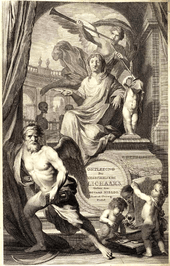 |
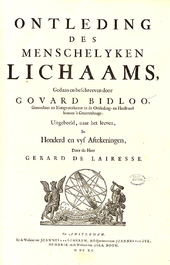 |
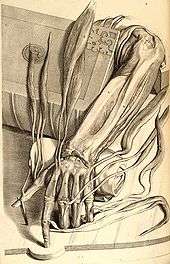 |
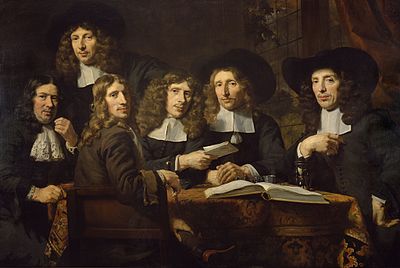 Nicolaes Maes,Inspectors of the Amsterdam Surgeons' Guild, 1679/80, Bidloo, 30, head turned, in foreground |
References
- Miller Grinstead, Charles; Paul Peterson, William; Laurie Snell, James (2010). Probability Tales. USA: American Mathematical Society. p. 192. Retrieved 12 August 2014.
- Bidloo, Govard (1685). Anatomia humani corporis, centum & quinque tabulis, per artificiossis. G. de Lairesse ad vivum delineatis, demonstrata, veterum recentiorumque inventis explicata plurimisque, hactenus non detectis, illustrata. Amsterdam: Sumptibus viduæ J. a Someren – via University of Toronto Libraries.
- Andrews, J.S. (1999). Fasciolosis. Wallington: CABI publishing. pp. 1–29.
- "Library and Archive catalogue". Royal Society. Retrieved 14 December 2010.
Sources
External links
| Wikimedia Commons has media related to Govert Bidloo. |
- US National Institutes of Health: Historical Anatomies on the Web Govert Bidloo's Anatomia Humani Corporis (Ontleding des menschelyken lichaams)
- Godefridi Bidloo, Medicinae Doctoris & Chirurgi, Anatomia Hvmani Corporis: Centum & quinque Tabvlis Per artificiosiss. G. De Lairesse ad vivum delineatis, Demonstrata, Veterum Recentiorumque Inventis explicata plurimisque, hactenus non detectis, Illvstrata 105 illustrations. Amsterdam 1685
- Selected images from Anatomia humani corporis From The College of Physicians of Philadelphia Digital Library